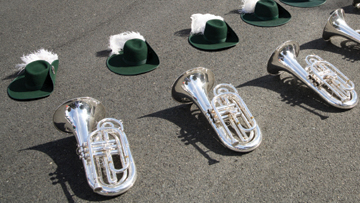You have free articles remaining this month.
Subscribe to the RP Witness for full access to new articles and the complete archives.
Continuing last month’s discussion of culturally conditioned celebrations, we turn to Judges 11:34. “When Jephtha came to his house at Mizpah, behold, his daughter was coming out to meet him with tambourines and with dancing.” Here Jephtha’s daughter celebrates his victory in battle over Ammon.
We read of a similar circumstance regarding David. “It happened as they were coming, when David returned from killing the Philistine, that the women came out of all the cities of Israel, singing and dancing, to meet King Saul, with tambourines, with joy and with musical instruments” (1 Sam. 18:6). As in the case of Miriam (Ex. 15:20-21), these celebrations involved special circumstances rather than stated meetings. Further, these are culturally shaped celebrations rather than being God directed and heaven filled.1
There are two other important incidents manifesting the air of celebration and also having a worshipful component. The first is 1 Chronicles 13:8, where David is celebrating the return of the ark of God from the Philistines. “David and all Israel were celebrating before God with all their might, even with songs and with lyres, harps, tambourines, cymbals and with trumpets.” We once again have a culturally shaped celebration. And once again, as in the case of Miriam, this celebration involves a special circumstance rather than a stated meeting. In addition, as a culturally shaped celebration, it stands in sharp contrast to the regular stated worship of God in the tabernacle and temple.2 The latter is quite specifically God directed and heaven imbued.
In 1 Samuel 10:5, King Saul meets a band of prophets prophesying and using tambourines, etc. Samuel makes this prediction: “You will come to the hill of God where the Philistine garrison is; and it shall be as soon as you have come there to the city, that you will meet a group of prophets coming down from the high place with harp, tambourine, flute, and a lyre before them, and they will be prophesying.” The prophets were prophesying; “they were in a condition of ecstatic inspiration, in which singing or speaking, with accompaniment of music, they gave expression to the overflowing feeling with which their hearts were filled from above by the controlling Spirit.”3
These ministers of God are singing with musical accompaniment; they are doing so under the influence of the Spirit. On one hand, we have a combination of instruments and singing as found in the temple. But as we have observed, the musical instruments are typological. They point to Spirit-empowered proclamation and praise, the exact circumstance of 1 Samuel 10:5.4 On the other hand, the celebratory activity of the prophets is clearly shaped by their contemporary culture. This once again contrasts with the regulated, God-ordained worship of the tabernacle and the temple.
But the temple and its services, not the occasional celebrations of the Old Testament, form the basis for New Testament worship. The New Testament repeatedly compares the church with the temple. The temple was the Old Testament designated place of worship. Today, the church assembled is the designated place for our worship.5
The celebrations of Miriam, Jephtha’s daughter, David, and Saul do not provide an apologetic for the use of instruments in the gatherings of God’s people for worship in the present era. These celebrations are culturally conditioned and shaped. These celebrations involve special circumstances and not stated meetings. Scripture shows them to be quite distinct from regular stated worship instituted by God in the tabernacle and temple.
We too have our celebrations, patriotic remembrances, Fourth of July gatherings, special banquets, and weddings,6 all of which are culturally shaped. We properly maintain they are quite distinct from the regular worship of God from which we properly exclude instrumental music.
Footnotes
-
“Celebration and Worship,” RP Witness, Oct. 2007, 11. ↩︎
-
To be more faithful to Scripture, I have replaced the distinction between “formal worship,” i.e., temple and tabernacle, and “informal worship settings,” i.e., celebrations, with “regular stated worship” and “culturally shaped celebrations.” Readers should also make this replacement in the previous article. ↩︎
-
David Erdmann, Lange’s Commentary on the Holy Scriptures, Zondervan, 1960, Vol. 5, p. 153. ↩︎
-
“Sound the Trumpet,” RP Witness, June 2007, 13; “Praise with Resounding Cymbals,” RP Witness, July 2007, 15; “Harps in Worship,” RP Witness, Aug. 2007, 15. ↩︎
-
See “Worship: God’s Communication of Covenant Grace,” RP Witness, Jan. 2007, 6-9; and “Places of Worship,” RP Witness, Mar./Apr. 2007, 11. ↩︎
-
The RPCNA does not consider weddings to be worship services. ↩︎
